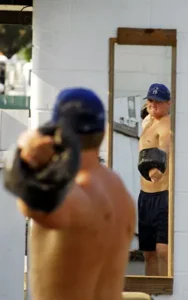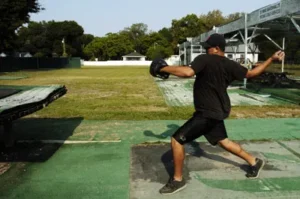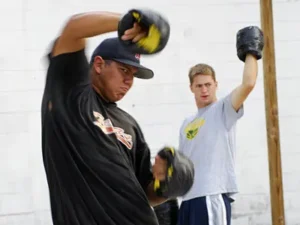 In the dynamic arena of baseball, the introduction of novel training methodologies can drastically transform both the performance levels and career longevity of pitchers. Dr. Mike Marshall's pioneering approach, which incorporates the use of Maxline Wrist Weights, stands out as a prime example of such innovation. This training technique is designed to improve pitchers' arm strength and mechanics by incorporating the resistance provided by these specialized weights during exercises. The use of these weights has ignited both interest and controversy within the baseball community, primarily because it proposes a radical shift in how pitchers train their arm movements. Critics and proponents alike delve into discussions about the efficacy and safety of this method, highlighting its potential to redefine pitching techniques. Dr. Marshall's approach is not just about strengthening; it's about reengineering the biomechanical movements of pitchers to enhance their control and power, which could potentially lead to improved performance and reduced injury rates. This conversation underscores a broader narrative in sports about the balance between tradition and innovation, especially in training regimens that could pivot the future of sports performance.
In the dynamic arena of baseball, the introduction of novel training methodologies can drastically transform both the performance levels and career longevity of pitchers. Dr. Mike Marshall's pioneering approach, which incorporates the use of Maxline Wrist Weights, stands out as a prime example of such innovation. This training technique is designed to improve pitchers' arm strength and mechanics by incorporating the resistance provided by these specialized weights during exercises. The use of these weights has ignited both interest and controversy within the baseball community, primarily because it proposes a radical shift in how pitchers train their arm movements. Critics and proponents alike delve into discussions about the efficacy and safety of this method, highlighting its potential to redefine pitching techniques. Dr. Marshall's approach is not just about strengthening; it's about reengineering the biomechanical movements of pitchers to enhance their control and power, which could potentially lead to improved performance and reduced injury rates. This conversation underscores a broader narrative in sports about the balance between tradition and innovation, especially in training regimens that could pivot the future of sports performance.
 The Genesis of Wrist Weight Training: Maxline Wrist Weights
The Genesis of Wrist Weight Training: Maxline Wrist Weights
Dr. Mike Marshall, an advocate for advanced training techniques, developed a program that integrates wrist weights into the training regimen of pitchers. This program focuses on enhancing arm strength and mechanics through specialized drills.
Understanding the Drills
Dr. Marshall’s program includes several key exercises:
- Wrong Foot Slingshot
- Loaded Wrong Foot Slingshot
- Pendulum Swing Wind-Up
These drills are designed to improve the pitcher's arm speed and strength by simulating the pitching motion under increased resistance.
 The Science Behind the Technique: Maxline Wrist Weights
The Science Behind the Technique: Maxline Wrist Weights
The use of wrist weights creates a different dynamic in arm action compared to traditional pitching. Here’s how:
- Direct Force Application: The exercises encourage a linear force application, which is crucial for direct throws.
- Muscle Training: Heavier weights train the muscles to handle greater loads, theoretically enhancing control over standard baseball weights.
Specificity of Training
Dr. Marshall’s principle of specificity suggests that athletes should train in conditions that closely mimic actual sports performance. His program incorporates daily pitching sessions to ensure that skills are directly transferable to the game.
Differences in Arm Action: Maxline Wrist Weights
Despite the theoretical benefits, there are noticeable differences in arm action when transitioning from weighted exercises to actual pitching:
- Upward Force Application: With wrist weights, the force direction tends to be more upward compared to the more targeted, forward motion required in pitching.
Challenges and Misconceptions: Maxline Wrist Weights
The use of wrist weights in pitching training, as advocated by Dr. Mike Marshall, has not been without its critics, particularly concerning the potential long-term effects on a pitcher’s technique and effectiveness in actual games. The primary concern centers around the concept of muscle memory, which plays a critical role in how athletes execute skills under competitive conditions.
- Muscle Memory and Training Dynamics: Muscle memory refers to the way our bodies memorize certain movements through repetition, allowing these actions to become more automatic and requiring less conscious thought over time. In the context of using wrist weights, the muscle groups and motor patterns engaged are different from those used in a game setting without the extra weight. This training method involves heavier loads, which fundamentally alter the dynamics of the pitching motion. The worry is that training with significantly heavier weights could condition the muscles to adapt to these specific dynamics, potentially embedding movement patterns that are not optimal for pitching with a standard baseball, which is much lighter.
- Impact on Pitching Mechanics: The altered mechanics required to handle the additional weight might lead to a pitching style that is more forceful and less refined than what is ideal for accuracy and speed in game situations. For example, pitchers might develop a tendency to overemphasize certain movements, such as upward or forward thrusts, to compensate for the weight. This can create a discrepancy between practice and play, where the motions honed with weights do not translate effectively to the traditional pitching environment. This discrepancy can lead to less efficient, potentially awkward movements when the additional resistance of the weights is removed.
- Long-term Consequences: Over time, these inefficiencies could not only hinder performance but also increase the risk of injury. The repetitive use of an altered, possibly unnatural arm motion could place undue stress on different parts of the arm and shoulder, leading to strains or more serious injuries. The concern is that what benefits the pitcher in a controlled training setting might inadvertently set the stage for mechanical issues and physical setbacks in actual play.
- Balancing Training and Performance: Addressing these challenges requires a careful balance between harnessing the benefits of wrist weights for enhancing strength and endurance, and maintaining the natural, efficient mechanics of a pitcher's arm action. Coaches and trainers must be vigilant in monitoring the transfer effects of weighted training on pitching mechanics to ensure that the athletes retain the ability to perform optimally without weights on the mound.
In summary, while wrist weights can be a powerful tool for building muscle and enhancing pitcher strength, there is a significant need for strategic integration and constant evaluation to ensure that these training advancements do not backfire by distorting essential pitching mechanics.
Evaluating the Impact: Maxline Wrist Weights
It is essential to critically evaluate the impact of such training on a pitcher's performance. Adjustments in the training regimen may be necessary to optimize the benefits while minimizing potential drawbacks.
The Role of Heavy Weights
The use of heavy weights is believed to condition the muscles against gravity, preparing them for the lesser resistance encountered while pitching a baseball.
Conclusion: Maxline Wrist Weights
Dr. Mike Marshall's wrist weight training presents an intriguing, albeit controversial, approach to pitching training. It emphasizes the need for innovative training regimens but also underscores the importance of adaptability and specificity in athletic training.
FAQs: Maxline Wrist Weights
What are Maxline Wrist Weights?
Maxline Wrist Weights are specialized training tools used within Dr. Mike Marshall's innovative pitching training program. These weights are designed to be worn around the wrists, adding resistance to a pitcher's arm movements during training exercises. The additional weight helps in building muscle strength and enhancing the biomechanical efficiency of pitchers.
How do wrist weights affect pitching?
Wrist weights have a significant impact on pitching by training the muscles to handle greater forces than those experienced with a standard baseball. This increased resistance can lead to improvements in both arm strength and stability, which are crucial for effective pitching. The use of these weights helps pitchers develop a stronger arm action and greater endurance, which can contribute to better performance on the mound.
What is the principle of specificity in training?
The principle of specificity in training is a fundamental concept that states training should be relevant and appropriate to the sport for which an individual is preparing. In practical terms, it means that the exercises and conditions under which an athlete trains should closely simulate the actual demands of their sport's performance. For pitchers, this principle underscores the importance of practicing with motions and resistances that mimic the actual pitching process, thereby enhancing the relevant skills and adaptations needed for optimal performance.
Why is there a difference in arm action with and without weights?
The difference in arm action when training with and without weights stems from the alterations in muscle memory and training dynamics. Training with weights modifies how the muscles coordinate and perform, due to the added resistance. These changes can lead to variations in movement patterns, which might not always directly translate to actions performed without weights. Pitchers need to adapt to the weight difference, which can temporarily alter their arm mechanics until they adjust to the standard pitching conditions without weights.
Can wrist weights improve pitching performance?
Yes, wrist weights have the potential to improve pitching performance if they are integrated correctly into the training regimen. By enhancing muscular strength and refining the mechanics of arm movements, these weights can help pitchers achieve greater velocity and control. However, the effectiveness of wrist weights also depends on how well they are incorporated with other training elements that focus on technique, agility, and endurance, ensuring a holistic approach to pitcher development.
For more exclusive content visit TopVelocity Patreon!


 The Genesis of Wrist Weight Training: Maxline Wrist Weights
The Genesis of Wrist Weight Training: Maxline Wrist Weights The Science Behind the Technique: Maxline Wrist Weights
The Science Behind the Technique: Maxline Wrist Weights
